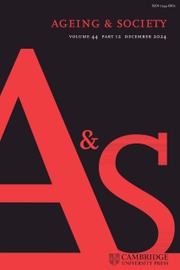Healthy Ageing in Singapore: Opportunities, Challenges and the Way Forward provides a thorough review and analysis of policy approaches and strategies to promote healthy ageing in Singapore, a highly developed, multi-ethnic country in Southeast Asia. The book consists of nine chapters, comprising two introductory chapters describing population ageing and the financial wellbeing of older Singaporeans; six in-depth chapters examining past, present and future perspectives on key aspects of healthy ageing; and a conclusion.
Chapter 1, ‘Population Ageing in Singapore’, articulates population-ageing trends globally, in the Asia-Pacific region and in Singapore. Specifically, the chapter introduces the Singaporean government’s responses to population ageing, reflecting the country’s ‘many helping hands’ approach, which prioritizes informal support systems, particularly family, before formal support systems. At the end of this chapter, the author clearly states her aim of assessing the past and current policies and strategies promoting healthy ageing in Singapore, focusing on the barriers and facilitators. Chapter 2, ‘Financial Well-Being of Older Adults’, provides detailed information on the factors that contribute to financial wellbeing, including financial literacy, the mandatory national social security system (the Central Provident Fund), personal savings and health status. The chapter underscores the importance of equipping individuals with financial literacy and planning skills over the lifecourse to ensure financial security in old age, calling for attention from individuals, communities and the government. Chapter 3, ‘Music Therapy for People with Dementia and Terminally Ill Patients’, presents research on music’s therapeutic value, along with the barriers to its advancement, which are rarely scrutinized in policy analyses.
Chapter 4, ‘Technologies and the Wellness of Older Adults’, and Chapter 5, ‘Digital Connection with Older Adults in the Time of Covid-19’, showcase innovative technological tools and their applications, as well as real-life examples of digital connections during the time of the Covid-19 pandemic, to discuss technological solutions with the human element of care for older adults. Chapter 6, ‘Enabling Ageing in Place’, presents four different community projects aimed at supporting the concept of ageing in place: SilverCOVE Senior Wellness Centre, Community for Successful Ageing at Whampoa, Exergaming competitions for older adults and Project ARTISAN (Aspiration and Resilience Through Intergenerational Storytelling and Art-based Narratives). These projects stress the active involvement of older adults throughout the whole process in the development of the services in question. Chapter 7, ‘The Creation of Dementia-Friendly Communities’, notes the need for government to develop and implement a national policy and build public awareness to destigmatize dementia. Chapter 8, ‘Advance Care Planning’, reviews benefits and barriers to fostering informed discussions on end-of-life planning. Chapter 9, ‘Afterword: Healthy Ageing in Singapore’, provides updates on more recent government initiatives and policy approaches as well as community movements for healthy ageing.
The statement that there is no ‘one-size-fits-all answer to … healthy ageing’ provides the foundation of the author’s argument throughout the book, enabling the author to explore various interconnected topics centred on the concept of healthy ageing, yet with the clear focus of finding the best practice in different conditions and situations. In this sense, the book is ambitious in scope; it delves into public policy, capturing diverse perspectives from key informants, along with data from government and industry reports, in addition to historical and recent statistics and academic research. The book is particularly engaging because it includes the voices of public officials, grassroots actors, field practitioners and ordinary people influenced by ageing-related changes and challenges. Occasionally, however, overly detailed information on past and current statistics and policy measures weakens the focus, potentially placing less emphasis on the author’s own evaluations and insights. Incorporating tables or graphical summaries for these sections (as shown in Chapter 7) could help streamline the information and present the major points more concisely. Nevertheless, the information and insights presented in this book can be applied in an international context, especially for other countries looking for the most up-to-date public policy responses to promoting healthy ageing, to help them address their current and expected issues and challenges.


